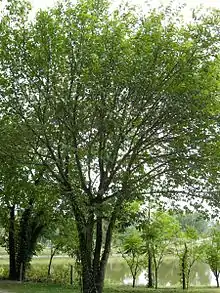Artocarpus lacucha
Artocarpus lacucha, also known as monkey fruit,[1] or Monkey Jack[1] or barhar (Hindi:बरहङ), badahar (Nepali:बडहर) or dewa (Assamese: ডেৱা, Bengali: ডেউয়া) or bohot (Assamese: বহঁত) or Heirikokthong (Meeteilon:ꯍꯩꯔꯤꯀꯣꯛꯊꯣꯡ) and 'Taat' in Thadou-Kuki language of Northeast India, is a tropical evergreen tree species of the family Moraceae. It is distributed throughout the Indian Subcontinent and Southeast Asia.[2] The tree is valued for its wood; its fruit is edible and is believed to have medicinal value.[3] In Northeastern Thailand, the wood is used to make pong lang, a local traditional instrument.[4]
| Artocarpus lacucha | |
|---|---|
 | |
| Scientific classification | |
| Kingdom: | Plantae |
| Clade: | Tracheophytes |
| Clade: | Angiosperms |
| Clade: | Eudicots |
| Clade: | Rosids |
| Order: | Rosales |
| Family: | Moraceae |
| Genus: | Artocarpus |
| Species: | A. lacucha |
| Binomial name | |
| Artocarpus lacucha | |
| Synonyms | |
| |
The stilbenoid oxyresveratrol can be isolated from the heartwood of A. lakoocha[5] as well as in Puag Haad, the light brown powder obtained from the aqueous extract of the wood chips of A. lakoocha Roxb by boiling, then slow evaporation, followed by cooling. This traditional drug is effective against the intestinal fluke Haplorchis taichui[6] or against taeniasis.[7]
This tree is mentioned in the Arthashastra.[8]
See also
- Domesticated plants and animals of Austronesia
- Barharwa: A town in India named after the Hindi word for Artocarpus lacucha (Barhar)
References
- "Artocarpus lacucha". Germplasm Resources Information Network (GRIN). Agricultural Research Service (ARS), United States Department of Agriculture (USDA). Retrieved 1 August 2014.
- Pankaj Oudhia, Robert E. Paull. Monkey Jack Artocarpus lakoocha Roxb., Moraceae p485-487.Encyclopedia of Fruit and Nuts - 2008, J. Janick and R. E. Paull -editors, CABI, Wallingford, United Kingdom
- Lakoocha: A Multipurpose Tree of Warm Climate
- Cruz-Garcia, Gisella S.; Price, Lisa L. (2011). "Ethnobotanical investigation of 'wild' food plants used by rice farmers in Kalasin, Northeast Thailand". Journal of Ethnobiology and Ethnomedicine. 7: 33. doi:10.1186/1746-4269-7-33. PMC 3233498. PMID 22067578.
- Maneechai, S; Likhitwitayawuid, K; Sritularak, B; Palanuvej, C; Ruangrungsi, N; Sirisa-Ard, P (2009). "Quantitative analysis of oxyresveratrol content in Artocarpus lakoocha and 'Puag-Haad'". Medical Principles and Practice. 18 (3): 223–7. doi:10.1159/000204354. PMID 19349726. S2CID 29232919.
- Wongsawad, C; Wongsawad, P; Luangphai, P; Kumchoo, K (2005). "In vitro effects of aqueous extract from Artocarpus takoocha Roxb on tegumental surface of Haplorchis taichui" (PDF). The Southeast Asian Journal of Tropical Medicine and Public Health. 36 Suppl 4: 112–6. PMID 16438193. Archived from the original (PDF) on 2 December 2013.
- Charoenlarp, P; Radomyos, P; Bunnag, D (1989). "The optimum dose of Puag-Haad in the treatment of taeniasis". Journal of the Medical Association of Thailand = Chotmaihet Thangphaet. 72 (2): 71–3. PMID 2738489. INIST:7273462.
- Arthashastra/Book XIII
External links
 Media related to Artocarpus lakoocha at Wikimedia Commons
Media related to Artocarpus lakoocha at Wikimedia Commons Data related to Artocarpus lacucha at Wikispecies
Data related to Artocarpus lacucha at Wikispecies- Antioxidant and toxicity activities of Artocarpus lakoocha Roxb. heartwood extract
- Fruit with foliage
- Crops for the Future: Barhal (Artocarpus lakoocha)

